Effectiveness of Self-Regulation in Advertising: A Case Study of Meat and Livestock Australia Advertisement
VerifiedAdded on 2023/06/15
|12
|3103
|360
AI Summary
This article discusses the effectiveness of self-regulation in advertising, with a focus on the Meat and Livestock Australia advertisement promoting lamb. It analyzes the role of the Advertising Standards Bureau (ASB) in managing complaints and ensuring ethical advertising practices.
Contribute Materials
Your contribution can guide someone’s learning journey. Share your
documents today.

Secure Best Marks with AI Grader
Need help grading? Try our AI Grader for instant feedback on your assignments.
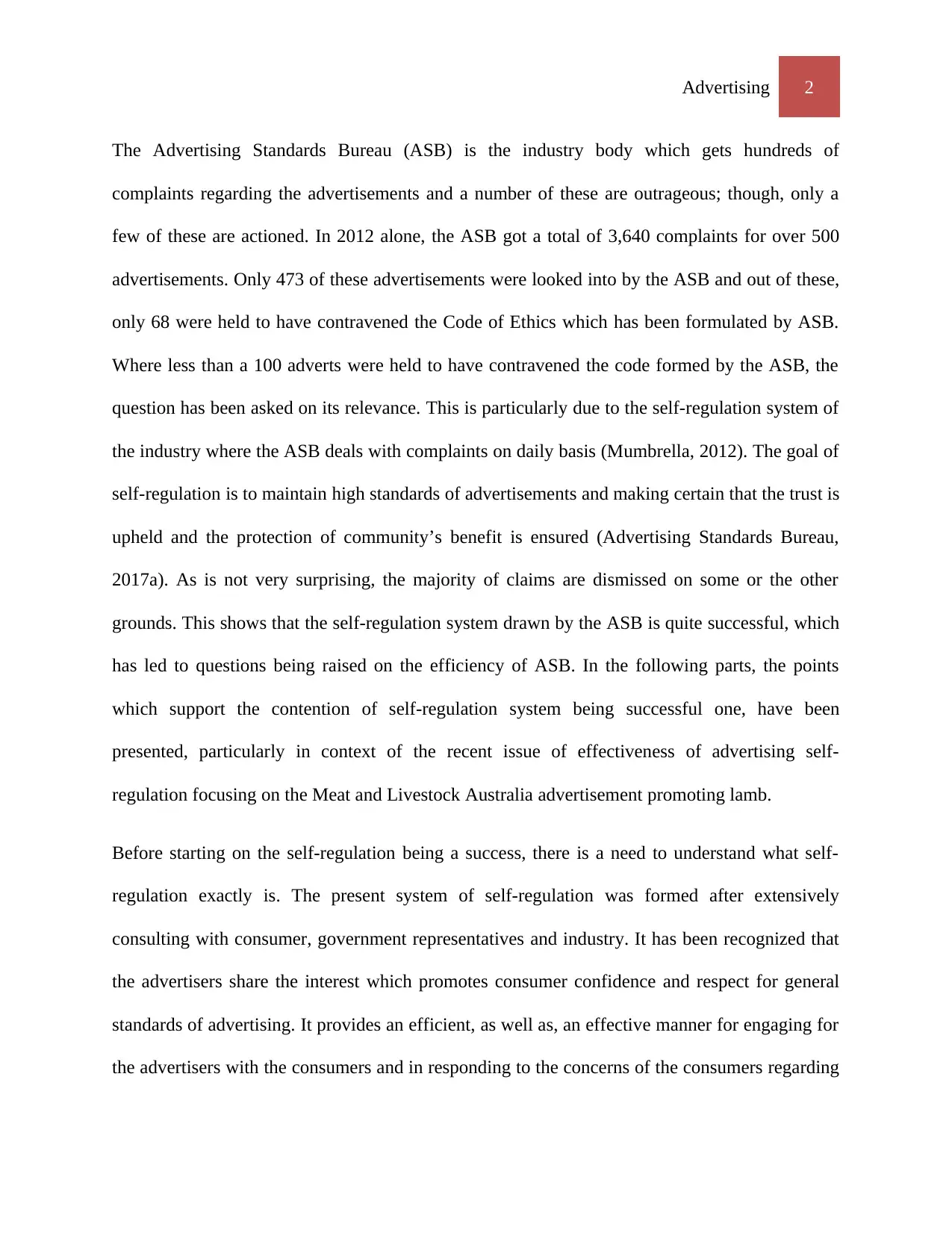
Advertising 2
The Advertising Standards Bureau (ASB) is the industry body which gets hundreds of
complaints regarding the advertisements and a number of these are outrageous; though, only a
few of these are actioned. In 2012 alone, the ASB got a total of 3,640 complaints for over 500
advertisements. Only 473 of these advertisements were looked into by the ASB and out of these,
only 68 were held to have contravened the Code of Ethics which has been formulated by ASB.
Where less than a 100 adverts were held to have contravened the code formed by the ASB, the
question has been asked on its relevance. This is particularly due to the self-regulation system of
the industry where the ASB deals with complaints on daily basis (Mumbrella, 2012). The goal of
self-regulation is to maintain high standards of advertisements and making certain that the trust is
upheld and the protection of community’s benefit is ensured (Advertising Standards Bureau,
2017a). As is not very surprising, the majority of claims are dismissed on some or the other
grounds. This shows that the self-regulation system drawn by the ASB is quite successful, which
has led to questions being raised on the efficiency of ASB. In the following parts, the points
which support the contention of self-regulation system being successful one, have been
presented, particularly in context of the recent issue of effectiveness of advertising self-
regulation focusing on the Meat and Livestock Australia advertisement promoting lamb.
Before starting on the self-regulation being a success, there is a need to understand what self-
regulation exactly is. The present system of self-regulation was formed after extensively
consulting with consumer, government representatives and industry. It has been recognized that
the advertisers share the interest which promotes consumer confidence and respect for general
standards of advertising. It provides an efficient, as well as, an effective manner for engaging for
the advertisers with the consumers and in responding to the concerns of the consumers regarding
The Advertising Standards Bureau (ASB) is the industry body which gets hundreds of
complaints regarding the advertisements and a number of these are outrageous; though, only a
few of these are actioned. In 2012 alone, the ASB got a total of 3,640 complaints for over 500
advertisements. Only 473 of these advertisements were looked into by the ASB and out of these,
only 68 were held to have contravened the Code of Ethics which has been formulated by ASB.
Where less than a 100 adverts were held to have contravened the code formed by the ASB, the
question has been asked on its relevance. This is particularly due to the self-regulation system of
the industry where the ASB deals with complaints on daily basis (Mumbrella, 2012). The goal of
self-regulation is to maintain high standards of advertisements and making certain that the trust is
upheld and the protection of community’s benefit is ensured (Advertising Standards Bureau,
2017a). As is not very surprising, the majority of claims are dismissed on some or the other
grounds. This shows that the self-regulation system drawn by the ASB is quite successful, which
has led to questions being raised on the efficiency of ASB. In the following parts, the points
which support the contention of self-regulation system being successful one, have been
presented, particularly in context of the recent issue of effectiveness of advertising self-
regulation focusing on the Meat and Livestock Australia advertisement promoting lamb.
Before starting on the self-regulation being a success, there is a need to understand what self-
regulation exactly is. The present system of self-regulation was formed after extensively
consulting with consumer, government representatives and industry. It has been recognized that
the advertisers share the interest which promotes consumer confidence and respect for general
standards of advertising. It provides an efficient, as well as, an effective manner for engaging for
the advertisers with the consumers and in responding to the concerns of the consumers regarding
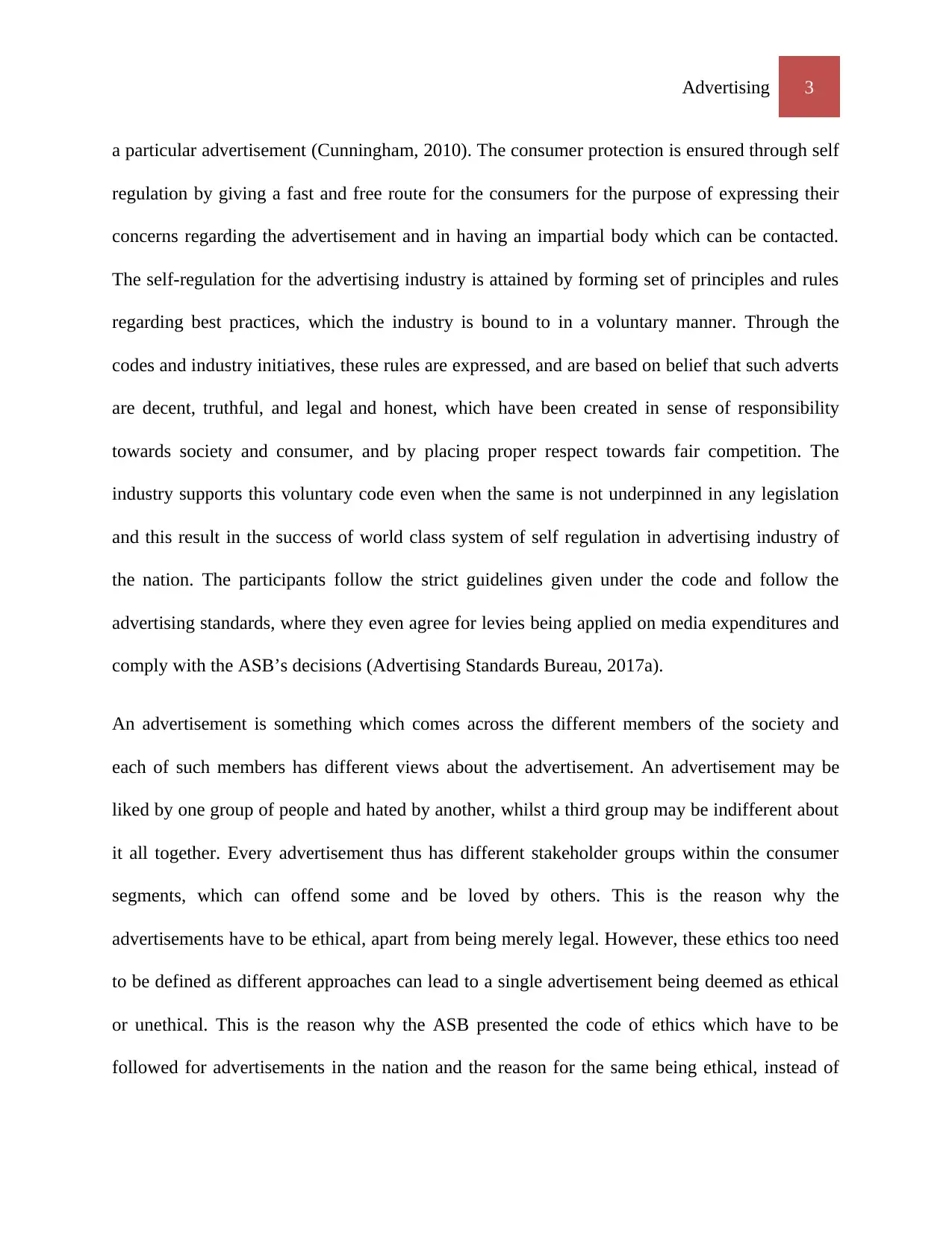
Advertising 3
a particular advertisement (Cunningham, 2010). The consumer protection is ensured through self
regulation by giving a fast and free route for the consumers for the purpose of expressing their
concerns regarding the advertisement and in having an impartial body which can be contacted.
The self-regulation for the advertising industry is attained by forming set of principles and rules
regarding best practices, which the industry is bound to in a voluntary manner. Through the
codes and industry initiatives, these rules are expressed, and are based on belief that such adverts
are decent, truthful, and legal and honest, which have been created in sense of responsibility
towards society and consumer, and by placing proper respect towards fair competition. The
industry supports this voluntary code even when the same is not underpinned in any legislation
and this result in the success of world class system of self regulation in advertising industry of
the nation. The participants follow the strict guidelines given under the code and follow the
advertising standards, where they even agree for levies being applied on media expenditures and
comply with the ASB’s decisions (Advertising Standards Bureau, 2017a).
An advertisement is something which comes across the different members of the society and
each of such members has different views about the advertisement. An advertisement may be
liked by one group of people and hated by another, whilst a third group may be indifferent about
it all together. Every advertisement thus has different stakeholder groups within the consumer
segments, which can offend some and be loved by others. This is the reason why the
advertisements have to be ethical, apart from being merely legal. However, these ethics too need
to be defined as different approaches can lead to a single advertisement being deemed as ethical
or unethical. This is the reason why the ASB presented the code of ethics which have to be
followed for advertisements in the nation and the reason for the same being ethical, instead of
a particular advertisement (Cunningham, 2010). The consumer protection is ensured through self
regulation by giving a fast and free route for the consumers for the purpose of expressing their
concerns regarding the advertisement and in having an impartial body which can be contacted.
The self-regulation for the advertising industry is attained by forming set of principles and rules
regarding best practices, which the industry is bound to in a voluntary manner. Through the
codes and industry initiatives, these rules are expressed, and are based on belief that such adverts
are decent, truthful, and legal and honest, which have been created in sense of responsibility
towards society and consumer, and by placing proper respect towards fair competition. The
industry supports this voluntary code even when the same is not underpinned in any legislation
and this result in the success of world class system of self regulation in advertising industry of
the nation. The participants follow the strict guidelines given under the code and follow the
advertising standards, where they even agree for levies being applied on media expenditures and
comply with the ASB’s decisions (Advertising Standards Bureau, 2017a).
An advertisement is something which comes across the different members of the society and
each of such members has different views about the advertisement. An advertisement may be
liked by one group of people and hated by another, whilst a third group may be indifferent about
it all together. Every advertisement thus has different stakeholder groups within the consumer
segments, which can offend some and be loved by others. This is the reason why the
advertisements have to be ethical, apart from being merely legal. However, these ethics too need
to be defined as different approaches can lead to a single advertisement being deemed as ethical
or unethical. This is the reason why the ASB presented the code of ethics which have to be
followed for advertisements in the nation and the reason for the same being ethical, instead of
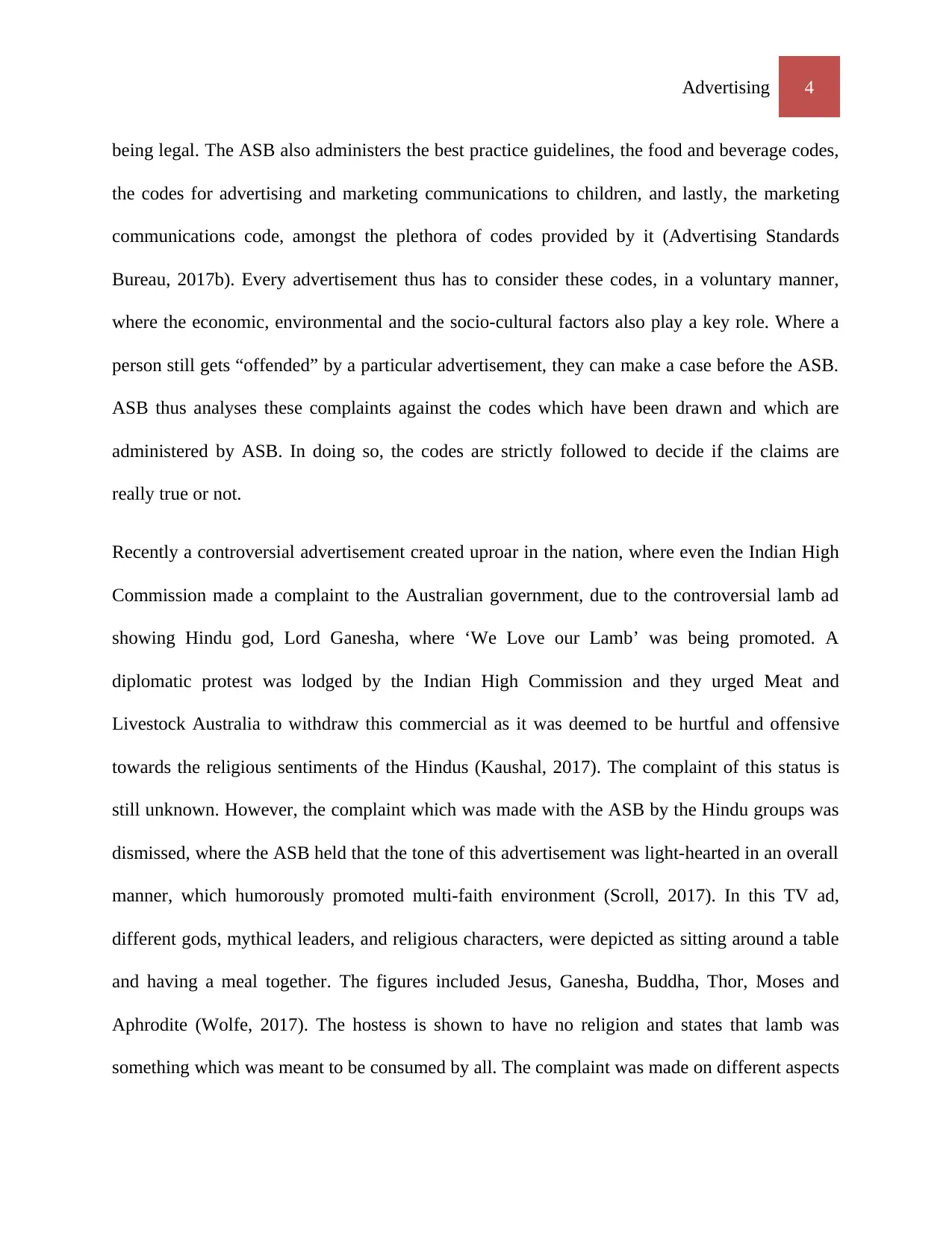
Advertising 4
being legal. The ASB also administers the best practice guidelines, the food and beverage codes,
the codes for advertising and marketing communications to children, and lastly, the marketing
communications code, amongst the plethora of codes provided by it (Advertising Standards
Bureau, 2017b). Every advertisement thus has to consider these codes, in a voluntary manner,
where the economic, environmental and the socio-cultural factors also play a key role. Where a
person still gets “offended” by a particular advertisement, they can make a case before the ASB.
ASB thus analyses these complaints against the codes which have been drawn and which are
administered by ASB. In doing so, the codes are strictly followed to decide if the claims are
really true or not.
Recently a controversial advertisement created uproar in the nation, where even the Indian High
Commission made a complaint to the Australian government, due to the controversial lamb ad
showing Hindu god, Lord Ganesha, where ‘We Love our Lamb’ was being promoted. A
diplomatic protest was lodged by the Indian High Commission and they urged Meat and
Livestock Australia to withdraw this commercial as it was deemed to be hurtful and offensive
towards the religious sentiments of the Hindus (Kaushal, 2017). The complaint of this status is
still unknown. However, the complaint which was made with the ASB by the Hindu groups was
dismissed, where the ASB held that the tone of this advertisement was light-hearted in an overall
manner, which humorously promoted multi-faith environment (Scroll, 2017). In this TV ad,
different gods, mythical leaders, and religious characters, were depicted as sitting around a table
and having a meal together. The figures included Jesus, Ganesha, Buddha, Thor, Moses and
Aphrodite (Wolfe, 2017). The hostess is shown to have no religion and states that lamb was
something which was meant to be consumed by all. The complaint was made on different aspects
being legal. The ASB also administers the best practice guidelines, the food and beverage codes,
the codes for advertising and marketing communications to children, and lastly, the marketing
communications code, amongst the plethora of codes provided by it (Advertising Standards
Bureau, 2017b). Every advertisement thus has to consider these codes, in a voluntary manner,
where the economic, environmental and the socio-cultural factors also play a key role. Where a
person still gets “offended” by a particular advertisement, they can make a case before the ASB.
ASB thus analyses these complaints against the codes which have been drawn and which are
administered by ASB. In doing so, the codes are strictly followed to decide if the claims are
really true or not.
Recently a controversial advertisement created uproar in the nation, where even the Indian High
Commission made a complaint to the Australian government, due to the controversial lamb ad
showing Hindu god, Lord Ganesha, where ‘We Love our Lamb’ was being promoted. A
diplomatic protest was lodged by the Indian High Commission and they urged Meat and
Livestock Australia to withdraw this commercial as it was deemed to be hurtful and offensive
towards the religious sentiments of the Hindus (Kaushal, 2017). The complaint of this status is
still unknown. However, the complaint which was made with the ASB by the Hindu groups was
dismissed, where the ASB held that the tone of this advertisement was light-hearted in an overall
manner, which humorously promoted multi-faith environment (Scroll, 2017). In this TV ad,
different gods, mythical leaders, and religious characters, were depicted as sitting around a table
and having a meal together. The figures included Jesus, Ganesha, Buddha, Thor, Moses and
Aphrodite (Wolfe, 2017). The hostess is shown to have no religion and states that lamb was
something which was meant to be consumed by all. The complaint was made on different aspects
Secure Best Marks with AI Grader
Need help grading? Try our AI Grader for instant feedback on your assignments.
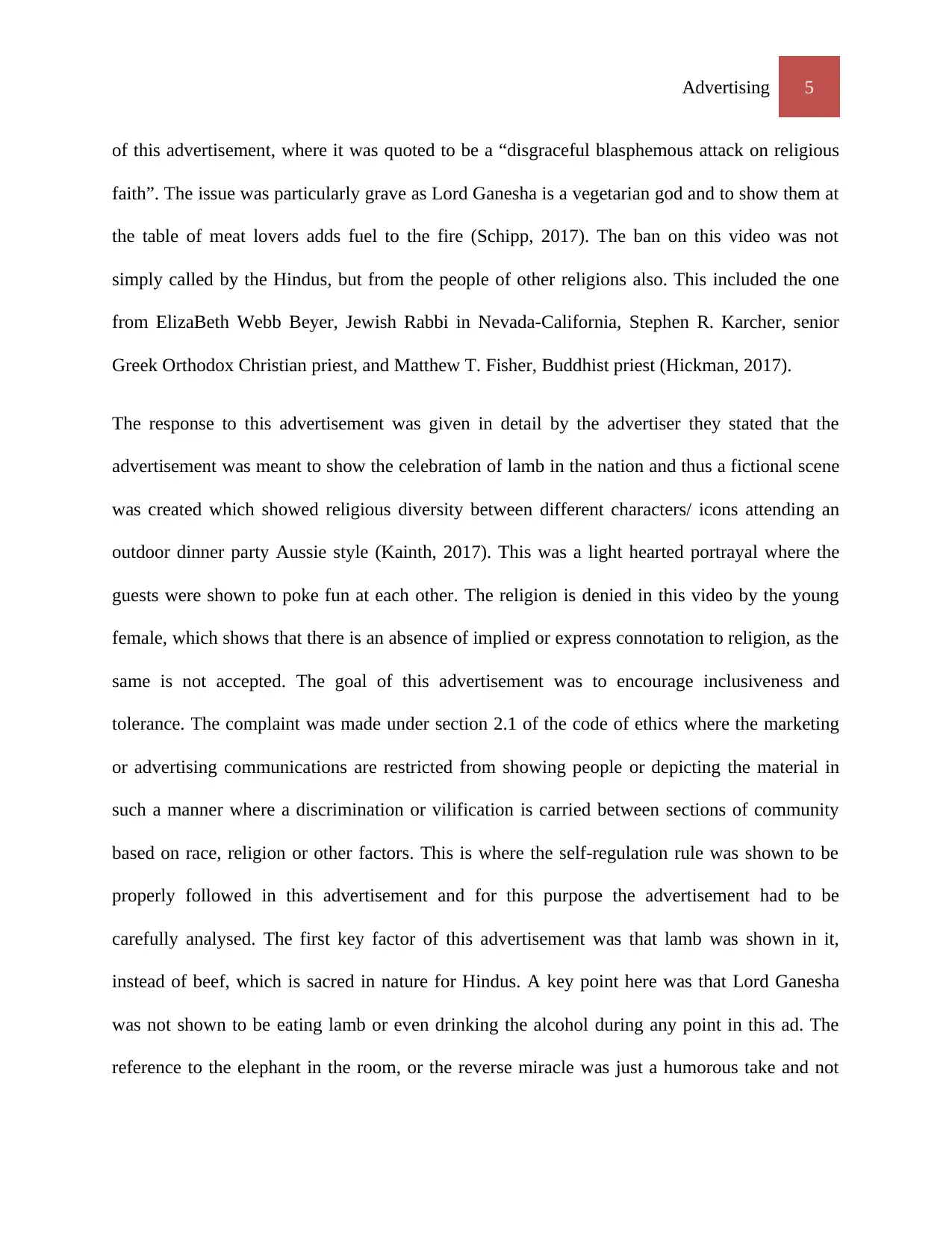
Advertising 5
of this advertisement, where it was quoted to be a “disgraceful blasphemous attack on religious
faith”. The issue was particularly grave as Lord Ganesha is a vegetarian god and to show them at
the table of meat lovers adds fuel to the fire (Schipp, 2017). The ban on this video was not
simply called by the Hindus, but from the people of other religions also. This included the one
from ElizaBeth Webb Beyer, Jewish Rabbi in Nevada-California, Stephen R. Karcher, senior
Greek Orthodox Christian priest, and Matthew T. Fisher, Buddhist priest (Hickman, 2017).
The response to this advertisement was given in detail by the advertiser they stated that the
advertisement was meant to show the celebration of lamb in the nation and thus a fictional scene
was created which showed religious diversity between different characters/ icons attending an
outdoor dinner party Aussie style (Kainth, 2017). This was a light hearted portrayal where the
guests were shown to poke fun at each other. The religion is denied in this video by the young
female, which shows that there is an absence of implied or express connotation to religion, as the
same is not accepted. The goal of this advertisement was to encourage inclusiveness and
tolerance. The complaint was made under section 2.1 of the code of ethics where the marketing
or advertising communications are restricted from showing people or depicting the material in
such a manner where a discrimination or vilification is carried between sections of community
based on race, religion or other factors. This is where the self-regulation rule was shown to be
properly followed in this advertisement and for this purpose the advertisement had to be
carefully analysed. The first key factor of this advertisement was that lamb was shown in it,
instead of beef, which is sacred in nature for Hindus. A key point here was that Lord Ganesha
was not shown to be eating lamb or even drinking the alcohol during any point in this ad. The
reference to the elephant in the room, or the reverse miracle was just a humorous take and not
of this advertisement, where it was quoted to be a “disgraceful blasphemous attack on religious
faith”. The issue was particularly grave as Lord Ganesha is a vegetarian god and to show them at
the table of meat lovers adds fuel to the fire (Schipp, 2017). The ban on this video was not
simply called by the Hindus, but from the people of other religions also. This included the one
from ElizaBeth Webb Beyer, Jewish Rabbi in Nevada-California, Stephen R. Karcher, senior
Greek Orthodox Christian priest, and Matthew T. Fisher, Buddhist priest (Hickman, 2017).
The response to this advertisement was given in detail by the advertiser they stated that the
advertisement was meant to show the celebration of lamb in the nation and thus a fictional scene
was created which showed religious diversity between different characters/ icons attending an
outdoor dinner party Aussie style (Kainth, 2017). This was a light hearted portrayal where the
guests were shown to poke fun at each other. The religion is denied in this video by the young
female, which shows that there is an absence of implied or express connotation to religion, as the
same is not accepted. The goal of this advertisement was to encourage inclusiveness and
tolerance. The complaint was made under section 2.1 of the code of ethics where the marketing
or advertising communications are restricted from showing people or depicting the material in
such a manner where a discrimination or vilification is carried between sections of community
based on race, religion or other factors. This is where the self-regulation rule was shown to be
properly followed in this advertisement and for this purpose the advertisement had to be
carefully analysed. The first key factor of this advertisement was that lamb was shown in it,
instead of beef, which is sacred in nature for Hindus. A key point here was that Lord Ganesha
was not shown to be eating lamb or even drinking the alcohol during any point in this ad. The
reference to the elephant in the room, or the reverse miracle was just a humorous take and not
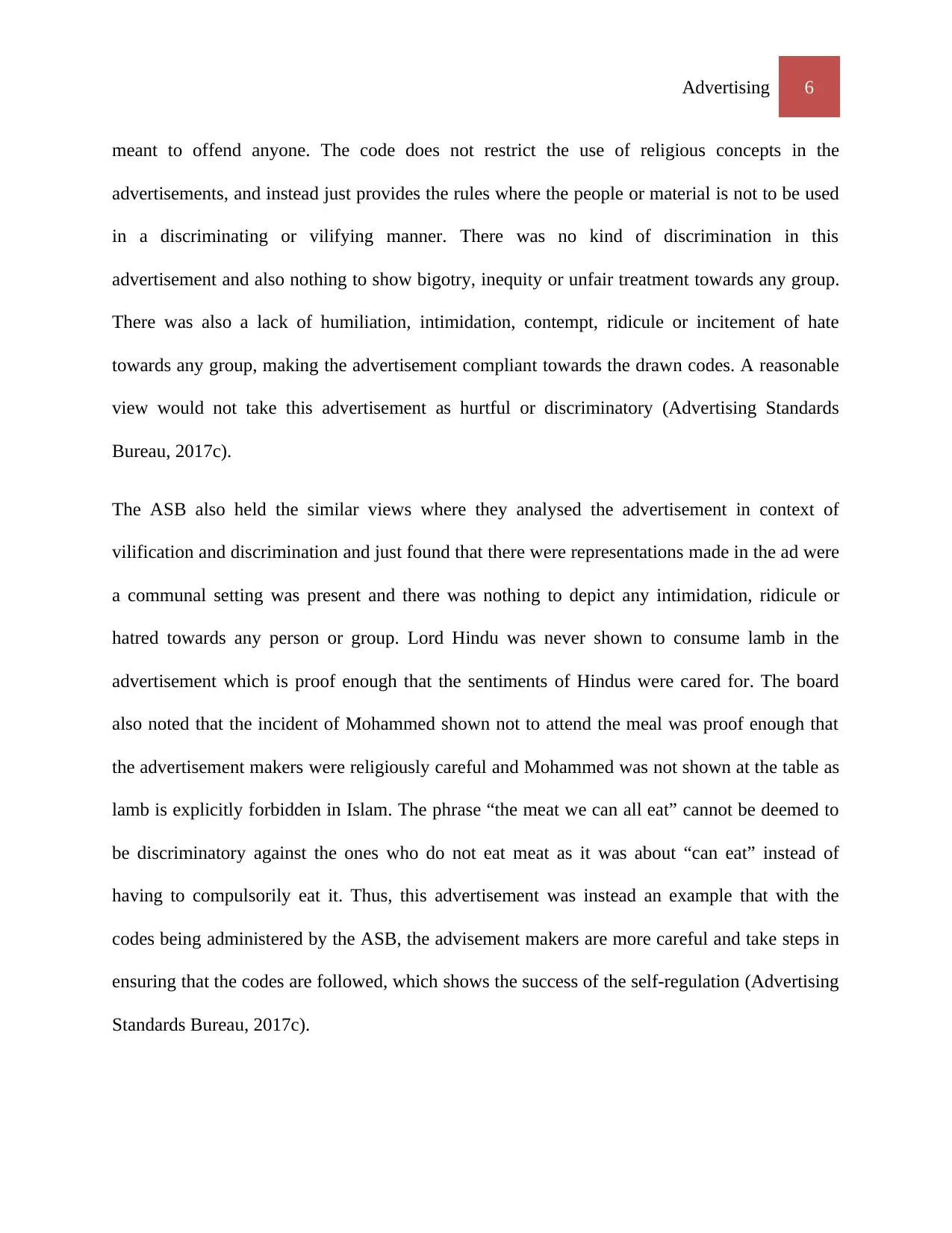
Advertising 6
meant to offend anyone. The code does not restrict the use of religious concepts in the
advertisements, and instead just provides the rules where the people or material is not to be used
in a discriminating or vilifying manner. There was no kind of discrimination in this
advertisement and also nothing to show bigotry, inequity or unfair treatment towards any group.
There was also a lack of humiliation, intimidation, contempt, ridicule or incitement of hate
towards any group, making the advertisement compliant towards the drawn codes. A reasonable
view would not take this advertisement as hurtful or discriminatory (Advertising Standards
Bureau, 2017c).
The ASB also held the similar views where they analysed the advertisement in context of
vilification and discrimination and just found that there were representations made in the ad were
a communal setting was present and there was nothing to depict any intimidation, ridicule or
hatred towards any person or group. Lord Hindu was never shown to consume lamb in the
advertisement which is proof enough that the sentiments of Hindus were cared for. The board
also noted that the incident of Mohammed shown not to attend the meal was proof enough that
the advertisement makers were religiously careful and Mohammed was not shown at the table as
lamb is explicitly forbidden in Islam. The phrase “the meat we can all eat” cannot be deemed to
be discriminatory against the ones who do not eat meat as it was about “can eat” instead of
having to compulsorily eat it. Thus, this advertisement was instead an example that with the
codes being administered by the ASB, the advisement makers are more careful and take steps in
ensuring that the codes are followed, which shows the success of the self-regulation (Advertising
Standards Bureau, 2017c).
meant to offend anyone. The code does not restrict the use of religious concepts in the
advertisements, and instead just provides the rules where the people or material is not to be used
in a discriminating or vilifying manner. There was no kind of discrimination in this
advertisement and also nothing to show bigotry, inequity or unfair treatment towards any group.
There was also a lack of humiliation, intimidation, contempt, ridicule or incitement of hate
towards any group, making the advertisement compliant towards the drawn codes. A reasonable
view would not take this advertisement as hurtful or discriminatory (Advertising Standards
Bureau, 2017c).
The ASB also held the similar views where they analysed the advertisement in context of
vilification and discrimination and just found that there were representations made in the ad were
a communal setting was present and there was nothing to depict any intimidation, ridicule or
hatred towards any person or group. Lord Hindu was never shown to consume lamb in the
advertisement which is proof enough that the sentiments of Hindus were cared for. The board
also noted that the incident of Mohammed shown not to attend the meal was proof enough that
the advertisement makers were religiously careful and Mohammed was not shown at the table as
lamb is explicitly forbidden in Islam. The phrase “the meat we can all eat” cannot be deemed to
be discriminatory against the ones who do not eat meat as it was about “can eat” instead of
having to compulsorily eat it. Thus, this advertisement was instead an example that with the
codes being administered by the ASB, the advisement makers are more careful and take steps in
ensuring that the codes are followed, which shows the success of the self-regulation (Advertising
Standards Bureau, 2017c).
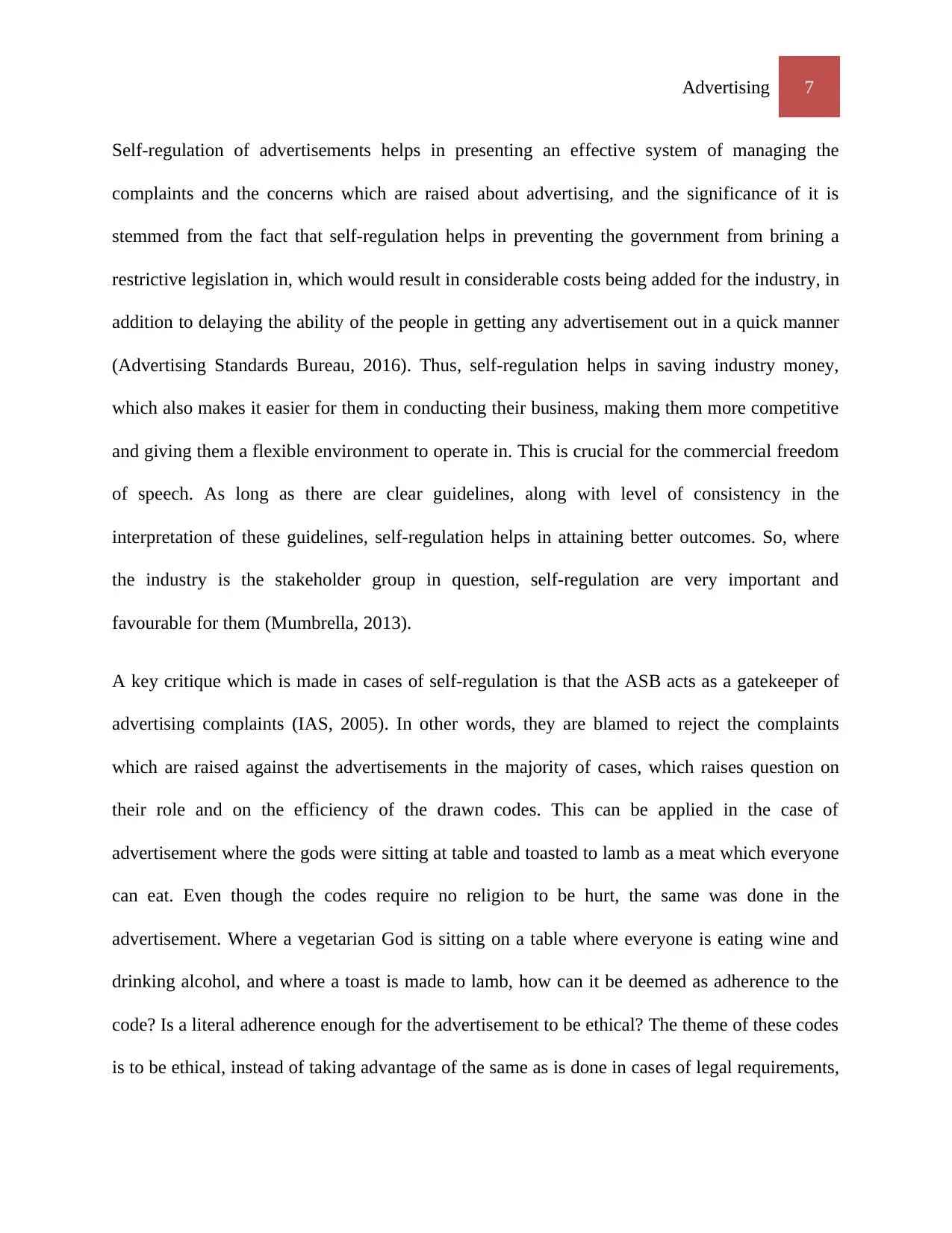
Advertising 7
Self-regulation of advertisements helps in presenting an effective system of managing the
complaints and the concerns which are raised about advertising, and the significance of it is
stemmed from the fact that self-regulation helps in preventing the government from brining a
restrictive legislation in, which would result in considerable costs being added for the industry, in
addition to delaying the ability of the people in getting any advertisement out in a quick manner
(Advertising Standards Bureau, 2016). Thus, self-regulation helps in saving industry money,
which also makes it easier for them in conducting their business, making them more competitive
and giving them a flexible environment to operate in. This is crucial for the commercial freedom
of speech. As long as there are clear guidelines, along with level of consistency in the
interpretation of these guidelines, self-regulation helps in attaining better outcomes. So, where
the industry is the stakeholder group in question, self-regulation are very important and
favourable for them (Mumbrella, 2013).
A key critique which is made in cases of self-regulation is that the ASB acts as a gatekeeper of
advertising complaints (IAS, 2005). In other words, they are blamed to reject the complaints
which are raised against the advertisements in the majority of cases, which raises question on
their role and on the efficiency of the drawn codes. This can be applied in the case of
advertisement where the gods were sitting at table and toasted to lamb as a meat which everyone
can eat. Even though the codes require no religion to be hurt, the same was done in the
advertisement. Where a vegetarian God is sitting on a table where everyone is eating wine and
drinking alcohol, and where a toast is made to lamb, how can it be deemed as adherence to the
code? Is a literal adherence enough for the advertisement to be ethical? The theme of these codes
is to be ethical, instead of taking advantage of the same as is done in cases of legal requirements,
Self-regulation of advertisements helps in presenting an effective system of managing the
complaints and the concerns which are raised about advertising, and the significance of it is
stemmed from the fact that self-regulation helps in preventing the government from brining a
restrictive legislation in, which would result in considerable costs being added for the industry, in
addition to delaying the ability of the people in getting any advertisement out in a quick manner
(Advertising Standards Bureau, 2016). Thus, self-regulation helps in saving industry money,
which also makes it easier for them in conducting their business, making them more competitive
and giving them a flexible environment to operate in. This is crucial for the commercial freedom
of speech. As long as there are clear guidelines, along with level of consistency in the
interpretation of these guidelines, self-regulation helps in attaining better outcomes. So, where
the industry is the stakeholder group in question, self-regulation are very important and
favourable for them (Mumbrella, 2013).
A key critique which is made in cases of self-regulation is that the ASB acts as a gatekeeper of
advertising complaints (IAS, 2005). In other words, they are blamed to reject the complaints
which are raised against the advertisements in the majority of cases, which raises question on
their role and on the efficiency of the drawn codes. This can be applied in the case of
advertisement where the gods were sitting at table and toasted to lamb as a meat which everyone
can eat. Even though the codes require no religion to be hurt, the same was done in the
advertisement. Where a vegetarian God is sitting on a table where everyone is eating wine and
drinking alcohol, and where a toast is made to lamb, how can it be deemed as adherence to the
code? Is a literal adherence enough for the advertisement to be ethical? The theme of these codes
is to be ethical, instead of taking advantage of the same as is done in cases of legal requirements,
Paraphrase This Document
Need a fresh take? Get an instant paraphrase of this document with our AI Paraphraser
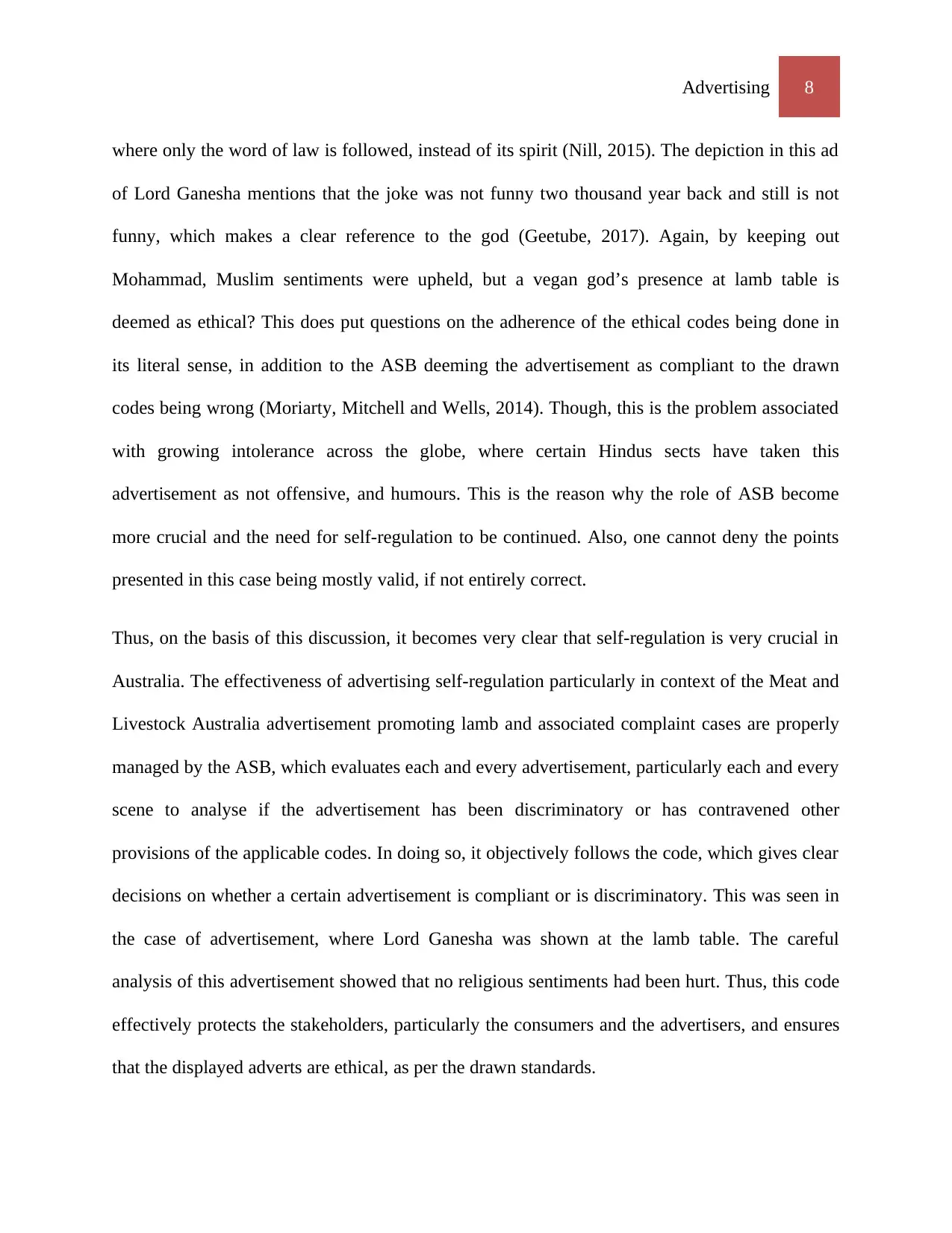
Advertising 8
where only the word of law is followed, instead of its spirit (Nill, 2015). The depiction in this ad
of Lord Ganesha mentions that the joke was not funny two thousand year back and still is not
funny, which makes a clear reference to the god (Geetube, 2017). Again, by keeping out
Mohammad, Muslim sentiments were upheld, but a vegan god’s presence at lamb table is
deemed as ethical? This does put questions on the adherence of the ethical codes being done in
its literal sense, in addition to the ASB deeming the advertisement as compliant to the drawn
codes being wrong (Moriarty, Mitchell and Wells, 2014). Though, this is the problem associated
with growing intolerance across the globe, where certain Hindus sects have taken this
advertisement as not offensive, and humours. This is the reason why the role of ASB become
more crucial and the need for self-regulation to be continued. Also, one cannot deny the points
presented in this case being mostly valid, if not entirely correct.
Thus, on the basis of this discussion, it becomes very clear that self-regulation is very crucial in
Australia. The effectiveness of advertising self-regulation particularly in context of the Meat and
Livestock Australia advertisement promoting lamb and associated complaint cases are properly
managed by the ASB, which evaluates each and every advertisement, particularly each and every
scene to analyse if the advertisement has been discriminatory or has contravened other
provisions of the applicable codes. In doing so, it objectively follows the code, which gives clear
decisions on whether a certain advertisement is compliant or is discriminatory. This was seen in
the case of advertisement, where Lord Ganesha was shown at the lamb table. The careful
analysis of this advertisement showed that no religious sentiments had been hurt. Thus, this code
effectively protects the stakeholders, particularly the consumers and the advertisers, and ensures
that the displayed adverts are ethical, as per the drawn standards.
where only the word of law is followed, instead of its spirit (Nill, 2015). The depiction in this ad
of Lord Ganesha mentions that the joke was not funny two thousand year back and still is not
funny, which makes a clear reference to the god (Geetube, 2017). Again, by keeping out
Mohammad, Muslim sentiments were upheld, but a vegan god’s presence at lamb table is
deemed as ethical? This does put questions on the adherence of the ethical codes being done in
its literal sense, in addition to the ASB deeming the advertisement as compliant to the drawn
codes being wrong (Moriarty, Mitchell and Wells, 2014). Though, this is the problem associated
with growing intolerance across the globe, where certain Hindus sects have taken this
advertisement as not offensive, and humours. This is the reason why the role of ASB become
more crucial and the need for self-regulation to be continued. Also, one cannot deny the points
presented in this case being mostly valid, if not entirely correct.
Thus, on the basis of this discussion, it becomes very clear that self-regulation is very crucial in
Australia. The effectiveness of advertising self-regulation particularly in context of the Meat and
Livestock Australia advertisement promoting lamb and associated complaint cases are properly
managed by the ASB, which evaluates each and every advertisement, particularly each and every
scene to analyse if the advertisement has been discriminatory or has contravened other
provisions of the applicable codes. In doing so, it objectively follows the code, which gives clear
decisions on whether a certain advertisement is compliant or is discriminatory. This was seen in
the case of advertisement, where Lord Ganesha was shown at the lamb table. The careful
analysis of this advertisement showed that no religious sentiments had been hurt. Thus, this code
effectively protects the stakeholders, particularly the consumers and the advertisers, and ensures
that the displayed adverts are ethical, as per the drawn standards.

Advertising 9
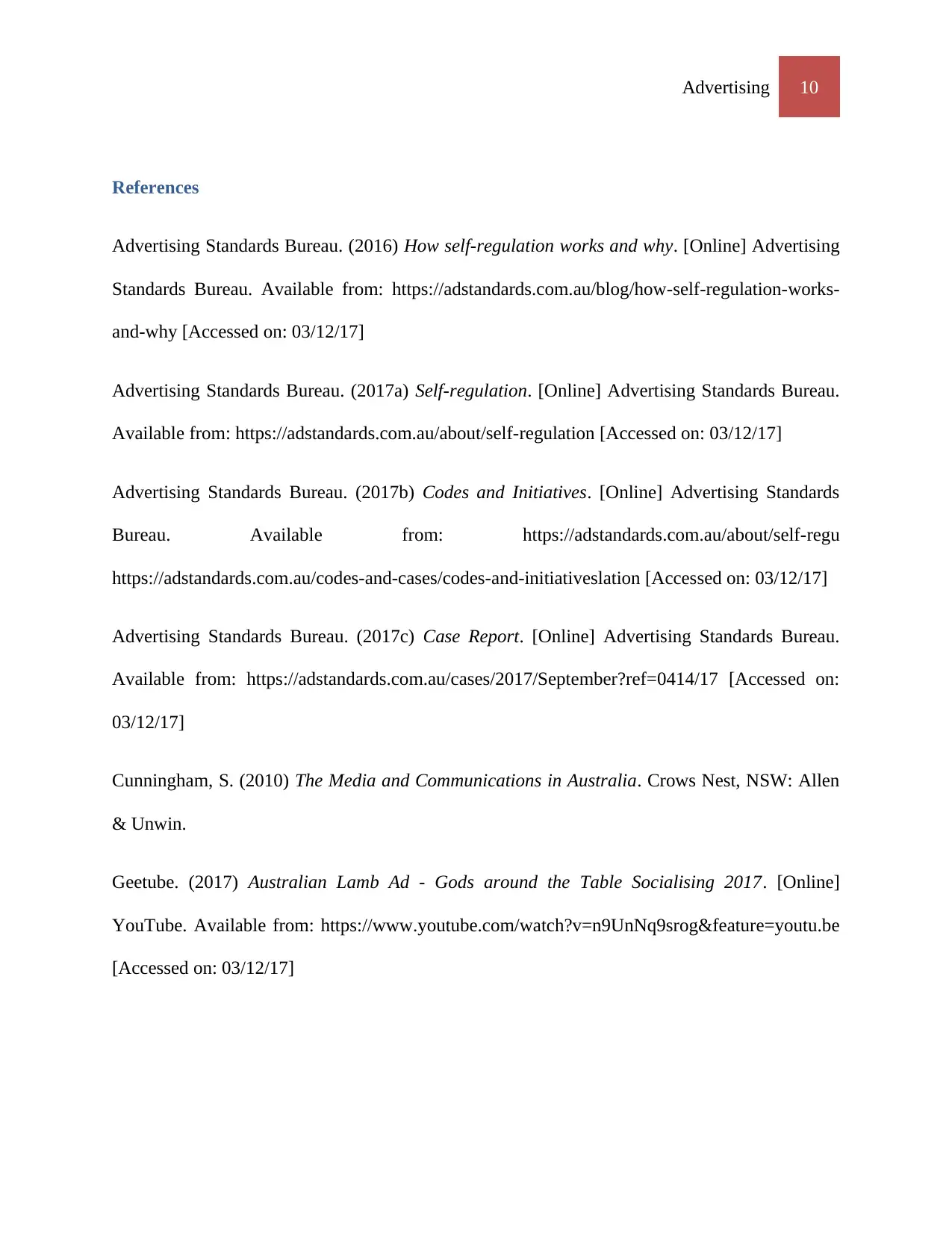
Advertising 10
References
Advertising Standards Bureau. (2016) How self-regulation works and why. [Online] Advertising
Standards Bureau. Available from: https://adstandards.com.au/blog/how-self-regulation-works-
and-why [Accessed on: 03/12/17]
Advertising Standards Bureau. (2017a) Self-regulation. [Online] Advertising Standards Bureau.
Available from: https://adstandards.com.au/about/self-regulation [Accessed on: 03/12/17]
Advertising Standards Bureau. (2017b) Codes and Initiatives. [Online] Advertising Standards
Bureau. Available from: https://adstandards.com.au/about/self-regu
https://adstandards.com.au/codes-and-cases/codes-and-initiativeslation [Accessed on: 03/12/17]
Advertising Standards Bureau. (2017c) Case Report. [Online] Advertising Standards Bureau.
Available from: https://adstandards.com.au/cases/2017/September?ref=0414/17 [Accessed on:
03/12/17]
Cunningham, S. (2010) The Media and Communications in Australia. Crows Nest, NSW: Allen
& Unwin.
Geetube. (2017) Australian Lamb Ad - Gods around the Table Socialising 2017. [Online]
YouTube. Available from: https://www.youtube.com/watch?v=n9UnNq9srog&feature=youtu.be
[Accessed on: 03/12/17]
References
Advertising Standards Bureau. (2016) How self-regulation works and why. [Online] Advertising
Standards Bureau. Available from: https://adstandards.com.au/blog/how-self-regulation-works-
and-why [Accessed on: 03/12/17]
Advertising Standards Bureau. (2017a) Self-regulation. [Online] Advertising Standards Bureau.
Available from: https://adstandards.com.au/about/self-regulation [Accessed on: 03/12/17]
Advertising Standards Bureau. (2017b) Codes and Initiatives. [Online] Advertising Standards
Bureau. Available from: https://adstandards.com.au/about/self-regu
https://adstandards.com.au/codes-and-cases/codes-and-initiativeslation [Accessed on: 03/12/17]
Advertising Standards Bureau. (2017c) Case Report. [Online] Advertising Standards Bureau.
Available from: https://adstandards.com.au/cases/2017/September?ref=0414/17 [Accessed on:
03/12/17]
Cunningham, S. (2010) The Media and Communications in Australia. Crows Nest, NSW: Allen
& Unwin.
Geetube. (2017) Australian Lamb Ad - Gods around the Table Socialising 2017. [Online]
YouTube. Available from: https://www.youtube.com/watch?v=n9UnNq9srog&feature=youtu.be
[Accessed on: 03/12/17]
Secure Best Marks with AI Grader
Need help grading? Try our AI Grader for instant feedback on your assignments.
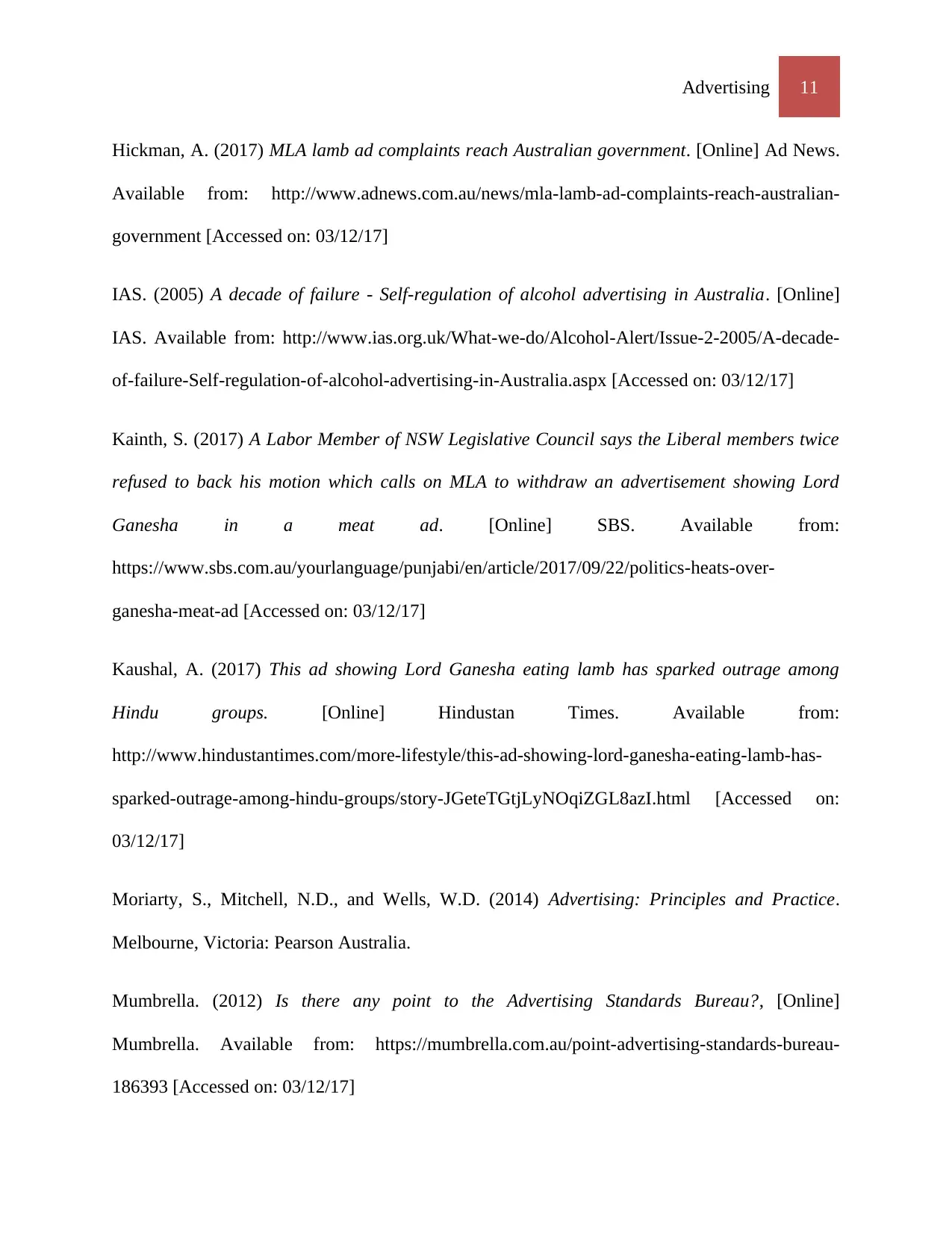
Advertising 11
Hickman, A. (2017) MLA lamb ad complaints reach Australian government. [Online] Ad News.
Available from: http://www.adnews.com.au/news/mla-lamb-ad-complaints-reach-australian-
government [Accessed on: 03/12/17]
IAS. (2005) A decade of failure - Self-regulation of alcohol advertising in Australia. [Online]
IAS. Available from: http://www.ias.org.uk/What-we-do/Alcohol-Alert/Issue-2-2005/A-decade-
of-failure-Self-regulation-of-alcohol-advertising-in-Australia.aspx [Accessed on: 03/12/17]
Kainth, S. (2017) A Labor Member of NSW Legislative Council says the Liberal members twice
refused to back his motion which calls on MLA to withdraw an advertisement showing Lord
Ganesha in a meat ad. [Online] SBS. Available from:
https://www.sbs.com.au/yourlanguage/punjabi/en/article/2017/09/22/politics-heats-over-
ganesha-meat-ad [Accessed on: 03/12/17]
Kaushal, A. (2017) This ad showing Lord Ganesha eating lamb has sparked outrage among
Hindu groups. [Online] Hindustan Times. Available from:
http://www.hindustantimes.com/more-lifestyle/this-ad-showing-lord-ganesha-eating-lamb-has-
sparked-outrage-among-hindu-groups/story-JGeteTGtjLyNOqiZGL8azI.html [Accessed on:
03/12/17]
Moriarty, S., Mitchell, N.D., and Wells, W.D. (2014) Advertising: Principles and Practice.
Melbourne, Victoria: Pearson Australia.
Mumbrella. (2012) Is there any point to the Advertising Standards Bureau?, [Online]
Mumbrella. Available from: https://mumbrella.com.au/point-advertising-standards-bureau-
186393 [Accessed on: 03/12/17]
Hickman, A. (2017) MLA lamb ad complaints reach Australian government. [Online] Ad News.
Available from: http://www.adnews.com.au/news/mla-lamb-ad-complaints-reach-australian-
government [Accessed on: 03/12/17]
IAS. (2005) A decade of failure - Self-regulation of alcohol advertising in Australia. [Online]
IAS. Available from: http://www.ias.org.uk/What-we-do/Alcohol-Alert/Issue-2-2005/A-decade-
of-failure-Self-regulation-of-alcohol-advertising-in-Australia.aspx [Accessed on: 03/12/17]
Kainth, S. (2017) A Labor Member of NSW Legislative Council says the Liberal members twice
refused to back his motion which calls on MLA to withdraw an advertisement showing Lord
Ganesha in a meat ad. [Online] SBS. Available from:
https://www.sbs.com.au/yourlanguage/punjabi/en/article/2017/09/22/politics-heats-over-
ganesha-meat-ad [Accessed on: 03/12/17]
Kaushal, A. (2017) This ad showing Lord Ganesha eating lamb has sparked outrage among
Hindu groups. [Online] Hindustan Times. Available from:
http://www.hindustantimes.com/more-lifestyle/this-ad-showing-lord-ganesha-eating-lamb-has-
sparked-outrage-among-hindu-groups/story-JGeteTGtjLyNOqiZGL8azI.html [Accessed on:
03/12/17]
Moriarty, S., Mitchell, N.D., and Wells, W.D. (2014) Advertising: Principles and Practice.
Melbourne, Victoria: Pearson Australia.
Mumbrella. (2012) Is there any point to the Advertising Standards Bureau?, [Online]
Mumbrella. Available from: https://mumbrella.com.au/point-advertising-standards-bureau-
186393 [Accessed on: 03/12/17]
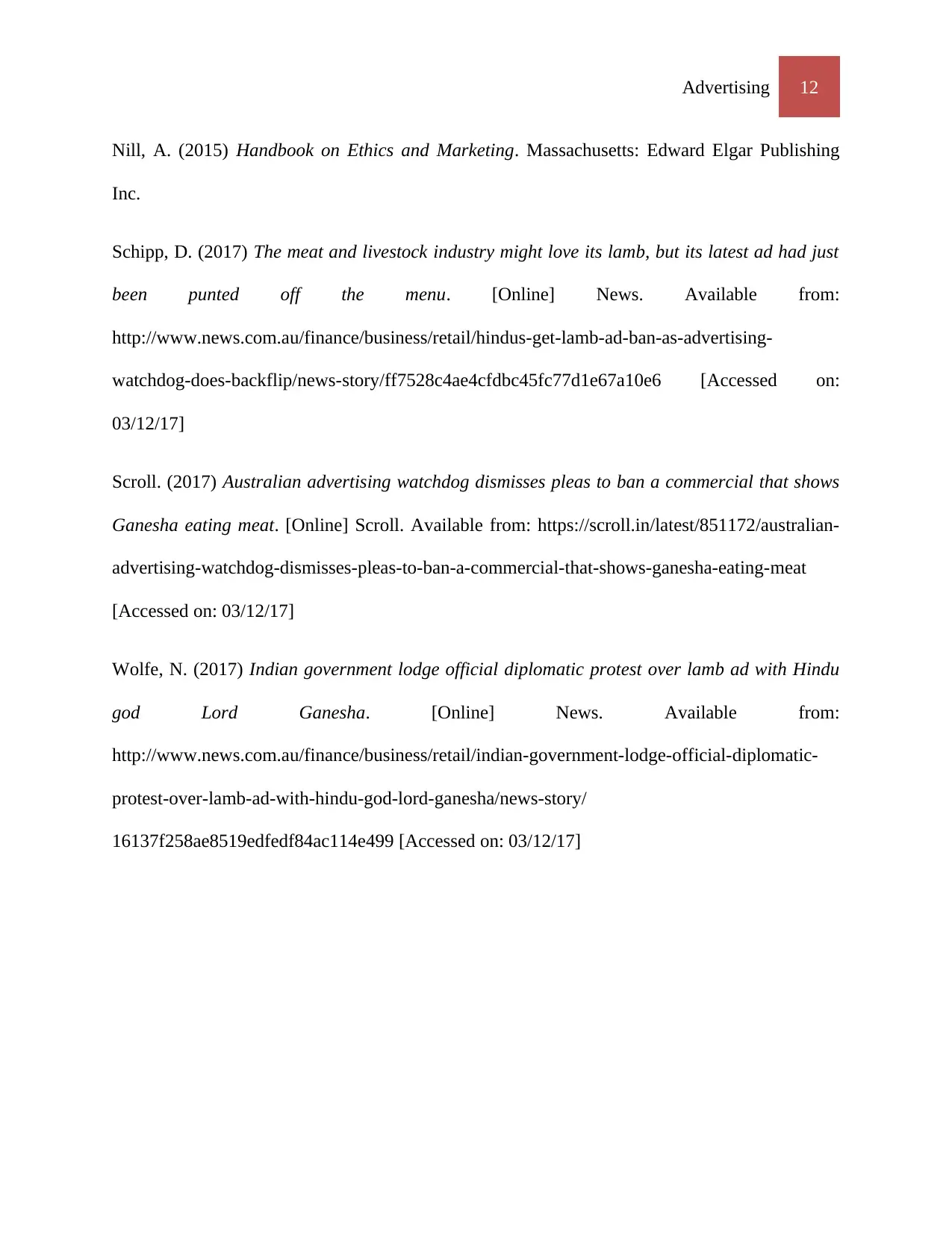
Advertising 12
Nill, A. (2015) Handbook on Ethics and Marketing. Massachusetts: Edward Elgar Publishing
Inc.
Schipp, D. (2017) The meat and livestock industry might love its lamb, but its latest ad had just
been punted off the menu. [Online] News. Available from:
http://www.news.com.au/finance/business/retail/hindus-get-lamb-ad-ban-as-advertising-
watchdog-does-backflip/news-story/ff7528c4ae4cfdbc45fc77d1e67a10e6 [Accessed on:
03/12/17]
Scroll. (2017) Australian advertising watchdog dismisses pleas to ban a commercial that shows
Ganesha eating meat. [Online] Scroll. Available from: https://scroll.in/latest/851172/australian-
advertising-watchdog-dismisses-pleas-to-ban-a-commercial-that-shows-ganesha-eating-meat
[Accessed on: 03/12/17]
Wolfe, N. (2017) Indian government lodge official diplomatic protest over lamb ad with Hindu
god Lord Ganesha. [Online] News. Available from:
http://www.news.com.au/finance/business/retail/indian-government-lodge-official-diplomatic-
protest-over-lamb-ad-with-hindu-god-lord-ganesha/news-story/
16137f258ae8519edfedf84ac114e499 [Accessed on: 03/12/17]
Nill, A. (2015) Handbook on Ethics and Marketing. Massachusetts: Edward Elgar Publishing
Inc.
Schipp, D. (2017) The meat and livestock industry might love its lamb, but its latest ad had just
been punted off the menu. [Online] News. Available from:
http://www.news.com.au/finance/business/retail/hindus-get-lamb-ad-ban-as-advertising-
watchdog-does-backflip/news-story/ff7528c4ae4cfdbc45fc77d1e67a10e6 [Accessed on:
03/12/17]
Scroll. (2017) Australian advertising watchdog dismisses pleas to ban a commercial that shows
Ganesha eating meat. [Online] Scroll. Available from: https://scroll.in/latest/851172/australian-
advertising-watchdog-dismisses-pleas-to-ban-a-commercial-that-shows-ganesha-eating-meat
[Accessed on: 03/12/17]
Wolfe, N. (2017) Indian government lodge official diplomatic protest over lamb ad with Hindu
god Lord Ganesha. [Online] News. Available from:
http://www.news.com.au/finance/business/retail/indian-government-lodge-official-diplomatic-
protest-over-lamb-ad-with-hindu-god-lord-ganesha/news-story/
16137f258ae8519edfedf84ac114e499 [Accessed on: 03/12/17]
1 out of 12
Your All-in-One AI-Powered Toolkit for Academic Success.
+13062052269
info@desklib.com
Available 24*7 on WhatsApp / Email
![[object Object]](/_next/static/media/star-bottom.7253800d.svg)
Unlock your academic potential
© 2024 | Zucol Services PVT LTD | All rights reserved.
